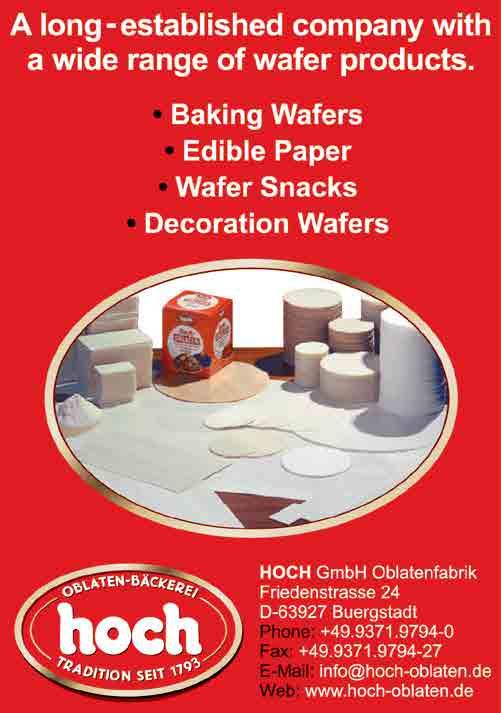
5 minute read
Global brand with a regional flavour Lambertz
GLOBAL BRAND WITH A REGIONAL FLAVOUR
Traditional German family biscuit maker, the Lambertz Group, is considered to be one of 250 reasons why we should love Germany. It seems the international confectionary company has become something of a national treasure with a reputation for blending traditional values with continuous, and profitable, innovations in its product line.


Established in 1688, Lambertz is not only the oldest brand in the country’s economic history but is also something of a national institution. This traditional family bakery business has also used its expertise to garner international success in the bakery business.
In 1820, Mr Henry Lambertz decided to add sugar to the company’s original biscuit mixture and then cut it into rectangular shapes. In doing so he created the company’s first range of ‘Printe’ – a traditional form of German pastry originating from the city of Aachen. Within a few years the Printe were manufactured in a variety of forms that included coating in chocolate, almonds, marzipan and the like.
What was a regional seasonal business today employs some 3,450 people and is the world market leader in seasonal baked products, as well as being one of the largest German year-round baked goods manufacturers.
Tradition and innovation
The Lambertz Group may well have cornered the global market for traditional German bakery specialities as the largest manufacturer of seasonal autumn bakery products, but it has also extended and strengthened its position above and beyond that of the domestic market.
Its focus remains on the two pillars of growth – maintaining and defending its dominance of its home grown market to preserve the rich tradition of a family owned and centuries-old company, while at the same time acting as a dynamic and innovative confectioner that doesn’t rest on its laurels.
Today it remains at its ancestral home in Aachen operating its subsidiaries Weiss – the southern German gingerbread manufacturer – Kinkartz and Haeberlein and Metzger, which incorporate the wellknown brands of Ferdinand Wolf, Türmer, Heeman, Feinbackerei Otten and Otto Scharschmidt Marzipan.
The group’s offering is pretty comprehensive and includes everything from biscuits and fruity baked products to lightly baked puff pastries, soft sugar-glazed doughnuts, marzipan and nougat pralines covered in milk chocolate, crispy mint flakes and Quark cakes with fruity fillings.
Key developments
Over the years Lambertz has developed from a small niche supplier of gingerbread and ginger biscuits to one of Germany’s top bakery producers, which achieves 60 per cent of its annual revenue from sales of its year-round goods rather than its seasonal range.
Not only that but the company’s track record at innovating new bakery products sets something of an example for competitors to follow; in fact, today Lambertz achieves more than 50 per cent of its turnover from items that were not even in its range 10 years ago. Just one of the many success stories in the last 10 years has been its Fine Lemon Pastry, which is known and loved throughout Germany.
Meanwhile product developments in terms of its winning seasonal range include the first Christmas praline Baccione, which is made from nougat, marzipan, chocolate and almonds, and Omas Gewurzgeback a, baked festive product with Christmas spices.
One of the reasons behind Lambertz’s success in the last 20 years, it seems, has been its decision to move from the manufacture of Printe into the entire gingerbread market. Up until 1978 Lambertz had been just another manufacturer of Printe, sharing a market in which there didn’t seem to be any real brand leader to speak of. Lambertz knew it could make the differ-

ence and, at a time when its annual turnover was something in the region of €8.2 million, the company took the initiative and invested some €3.1 million in a new domino manufacturing system. It knew it could fill the gap in the market by delivering another household brand name, and in this it was proved to be right.
In 2007, the company introduced its ‘Nussparade’ range of products, and this, combined with the growing popularity of its pastry mixes and mono pastries brought about a significant increase in sales. Increasing exports
As well as achieving greater penetration with its own branded products, Lambertz also undertakes private label work and is collaborating with some of the biggest retailers in the business. Its international business is rapidly expanding, and today the confectioner is exporting its baked goods to more than 40 countries with its year-round product lines, in particular, reaching a wider international audience.
In fact, one of the group’s focuses for the future is to expand its international exports, and indeed the company is making great progress in the US market, for example, where sales are continuing to increase. It has a sales centre in this market and has also established permanent listing with several large US retailers. Here it markets its year-round bakery products under the labels of ‘European cookies and German cookies’. In addition to the US, Lambertz has also established a strong presence in China, Japan and Africa.
Lambertz’s export business has been improved by the establishment, in 2008, of



a storage facility in Nuremberg with a storage capacity of 12,000 pallets. It has also expanded its distribution centre at Würselen to improve the flow and movement of goods from its factories to customers throughout the world.
Perfect for eastern Europe
Another of the most exciting areas for the company in the future, and also one where the company has considerable success in the past, is in the neighbouring market of Poland where Lambertz’s range of baked goods have sold particularly well. In fact the company’s penetration of the eastern European markets is another reason why Lambertz has been able to increase its turnover by so much over the last decade. Today its subsidiary Lambertz Polonia is selling to the Czech Republic, Romania, Ukraine, Latvia, Russia and Hungary as well as Poland.
Indeed the company’s bulging manufacturing portfolio provides further evidence of its success in Poland. As well as its six factories in Germany, Lambertz also produces in Poland, for the Polish and eastern European markets, and it is this site that has been the subject of investment recently in a bid to increase capacity. The demands of the market have led the company to invest in inaugurating two new baking lines at its Polish facility. As well using the capacity at the Polish facility, demand is such that Lambertz also utilises its German manufacturing sites to meet the need in the Polish market. It has also added several new products to its eastern European line over the past five years. n












